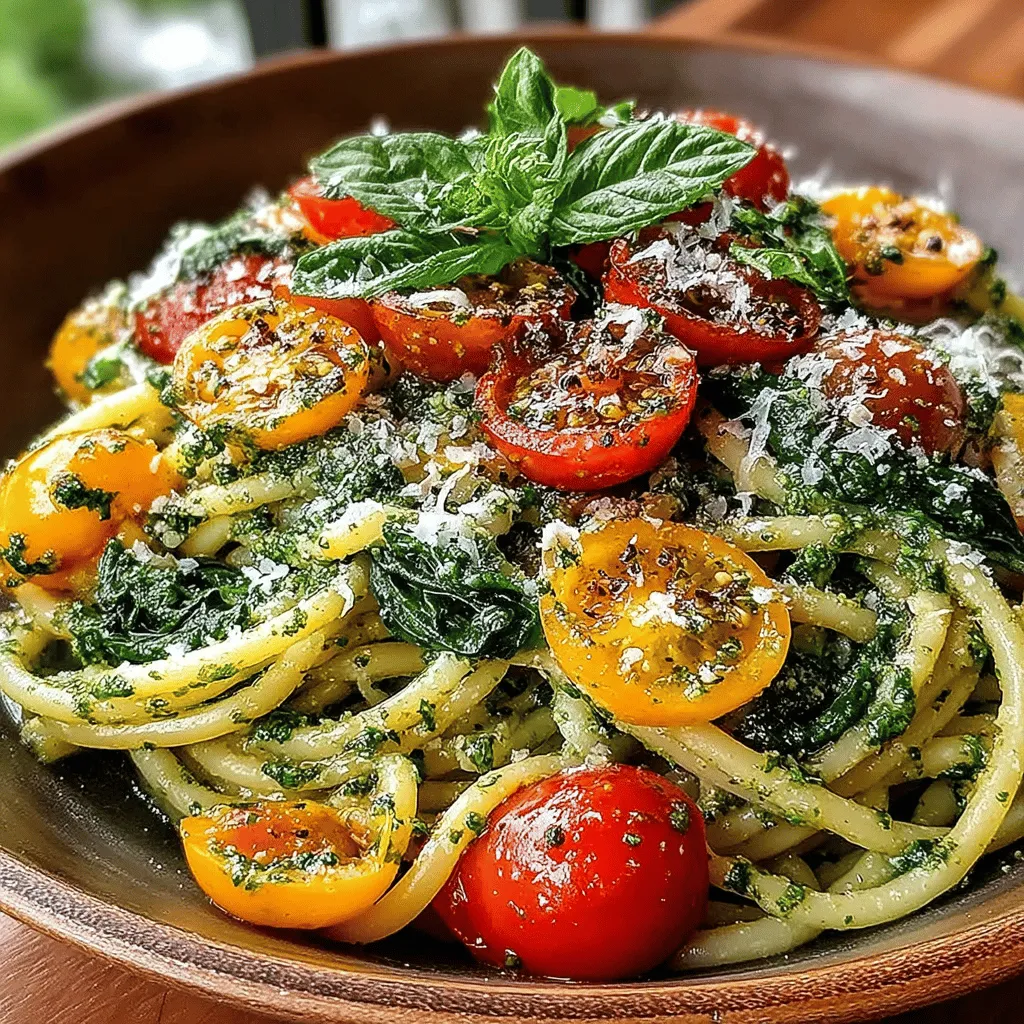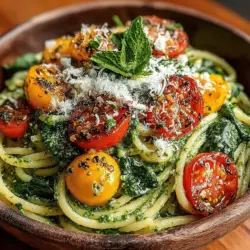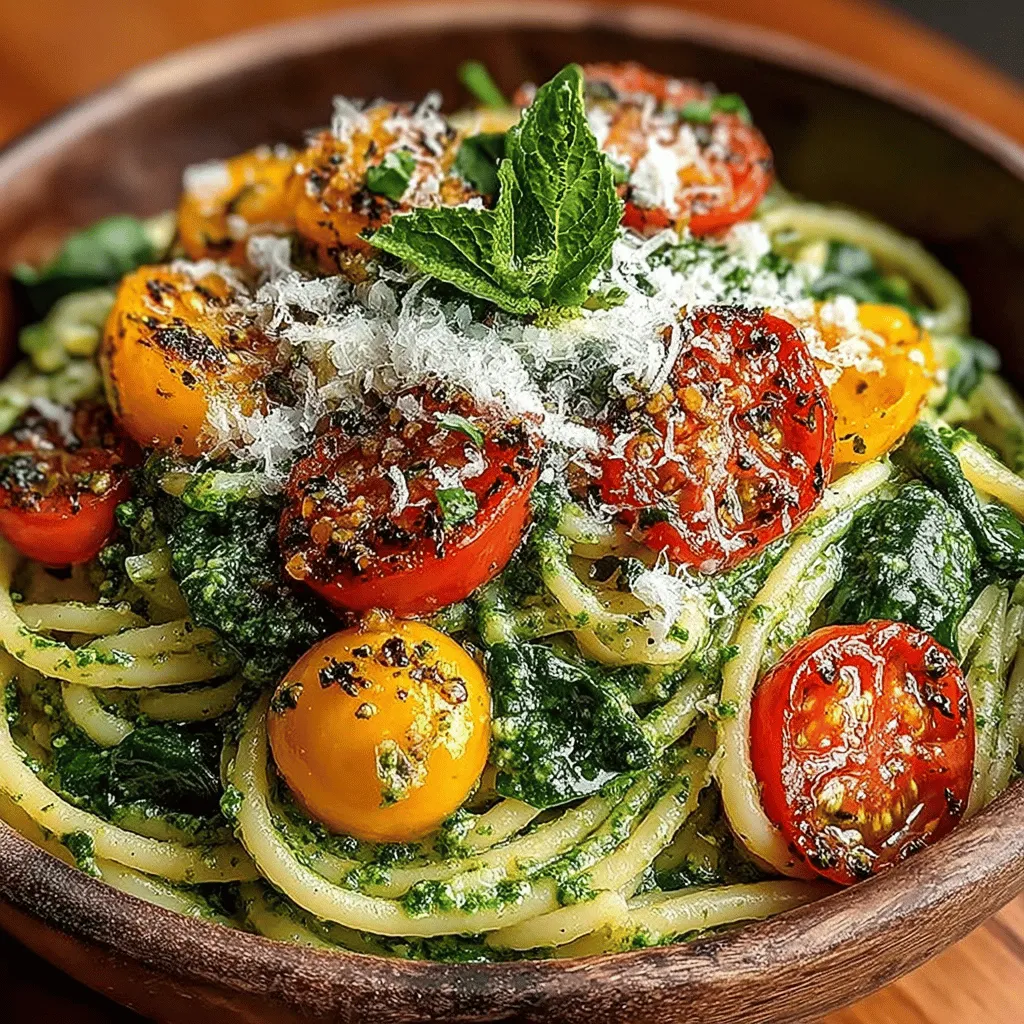Basil Pesto Pasta Extravaganza: A Fresh Taste of Italy
When it comes to Italian cuisine, few dishes encapsulate the essence of freshness and simplicity as beautifully as basil pesto pasta. Originating from the sun-drenched hills of Liguria, this dish marries the vibrant flavors of fresh basil with the comforting heartiness of pasta. The combination creates a culinary experience that is both delightful and satisfying, making it a beloved choice not just in Italy but around the world.
At the core of this dish is pesto, a vibrant green sauce that highlights the freshness of its ingredients. Traditionally made from basil, garlic, pine nuts, Parmesan cheese, and extra-virgin olive oil, pesto is celebrated for its rich flavor and versatility. While it serves as a perfect companion to pasta, it can also enhance sandwiches, salads, and grilled meats, proving that this simple sauce can elevate a variety of meals.
One of the reasons for the enduring popularity of basil pesto lies in its straightforward preparation. With just a few ingredients and minimal cooking, you can create a dish that feels gourmet yet accessible. Whether you’re a seasoned chef or a novice in the kitchen, the Basil Pesto Pasta Extravaganza offers an opportunity to impress with little effort, making it an ideal recipe for family gatherings, casual dinners, or even a quick weeknight meal.
Understanding Pesto
To truly appreciate basil pesto pasta, it’s essential to delve into the history and origins of pesto itself. The term “pesto” derives from the Italian word “pestare,” which means to crush or pound, referring to the traditional method of making pesto using a mortar and pestle. It originated in Genoa, Italy, where fresh basil grows abundantly, and it has since become a staple in Italian cuisine. This vibrant green sauce not only embodies the flavors of the Mediterranean but also reflects the culinary philosophy of using fresh, local ingredients.
Pesto has evolved over the years, leading to various adaptations around the globe. While the classic Genovese version remains the most popular, countless variations have emerged, including sun-dried tomato pesto, spinach pesto, and even vegan versions that substitute nuts and cheese with other flavorful ingredients. Each version brings its unique flair while maintaining the core principles of freshness and simplicity that pesto is renowned for.
The authenticity of any pesto lies primarily in the quality of its ingredients. Fresh basil is non-negotiable; its aromatic leaves provide the dish with its signature flavor. The vibrant green hue, combined with the nutty richness of cheese and the smooth texture of olive oil, creates a pesto that is both visually appealing and delicious. This focus on fresh ingredients is what makes basil pesto pasta such a standout dish.
Ingredients Overview
Fresh Basil Leaves
The star ingredient of any pesto is undoubtedly the fresh basil leaves. When selecting basil, look for vibrant, dark green leaves that are free from blemishes or wilting. Fresh basil not only contributes an irreplaceable flavor but also offers numerous nutritional benefits. It is rich in antioxidants and essential oils, promoting overall health and wellness. The aromatic compounds in basil, such as eugenol, also provide anti-inflammatory properties, making it a fantastic addition to any dish.
Parmesan Cheese
Parmesan cheese plays a crucial role in the flavor profile of basil pesto. Its sharp, nutty taste adds depth and richness to the sauce. When preparing your pesto, opt for high-quality, freshly grated Parmesan for the best flavor. If you’re looking to experiment, consider alternative cheeses like Pecorino Romano, which offers a saltier and more robust taste, or even a vegan cheese option for those adhering to plant-based diets.
Extra-Virgin Olive Oil
The choice of olive oil can make or break your pesto. High-quality extra-virgin olive oil is essential for achieving the right texture and flavor in your pesto. It not only brings a fruity richness but also helps to emulsify the sauce, creating a silky consistency that clings beautifully to your pasta. Beyond its flavor-enhancing properties, extra-virgin olive oil is packed with healthy fats and antioxidants, making it a heart-healthy choice for your culinary creations.
Pine Nuts vs. Walnuts
Traditionally, pine nuts are the go-to choice for pesto due to their delicate, buttery flavor. However, walnuts can provide a unique twist to your basil pesto, offering a slightly earthier taste that pairs well with the other ingredients. Both nuts are rich in healthy fats, protein, and essential nutrients, making them a nutritious addition to your dish. When selecting nuts, consider toasting them lightly to enhance their flavor before blending them into your pesto.
Garlic
Garlic is another essential component of classic pesto, contributing a pungent and savory kick that elevates the overall flavor. It not only adds a robust taste but also boasts numerous health benefits, including improved heart health and antimicrobial properties. For those who prefer a milder flavor, consider using roasted garlic instead of raw, as it offers a sweeter, more subtle taste while still providing the aromatic qualities that make pesto so appealing.
Pasta Choices
The choice of pasta is crucial for creating a well-rounded Basil Pesto Pasta Extravaganza. While traditional choices like spaghetti or linguine work beautifully, feel free to experiment with a variety of pasta shapes. Fusilli, penne, or even whole grain options can provide unique textures that hold the pesto beautifully. For those with dietary restrictions, gluten-free pasta offers a delicious alternative without compromising on flavor. Ultimately, the type of pasta you choose should complement the vibrant flavors of the pesto while providing a satisfying bite.
As you embark on creating your Basil Pesto Pasta Extravaganza, remember that the key lies in the freshness of your ingredients and the love you put into the preparation. With these foundational elements in place, you’ll be well on your way to crafting a dish that not only delights the palate but also brings a taste of Italy to your table. Stay tuned as we explore the preparation and cooking steps that will transform these ingredients into a mouthwatering meal.

Step-by-Step Guide to Making Basil Pesto
Preparing the Pesto
Creating a perfect basil pesto is all about balancing fresh ingredients to achieve a vibrant and flavorful sauce. To make this classic Italian sauce, begin by gathering your ingredients: fresh basil leaves, garlic, pine nuts, Parmesan cheese, and high-quality extra virgin olive oil.
Detailed Explanation of Using a Food Processor
Using a food processor is the most efficient way to prepare your pesto. Start by adding the fresh basil leaves, peeled garlic cloves, and pine nuts into the food processor bowl. Pulse these ingredients together until they achieve a coarse consistency. It’s important not to over-process at this stage; you want to maintain some texture.
Next, add grated Parmesan cheese to the mixture. This will add a nutty and savory flavor that complements the freshness of the basil. Pulse the mixture again until the cheese is well incorporated.
Tips on Achieving the Perfect Consistency
The consistency of your pesto is crucial; it should be smooth but not overly processed. If you find that the mixture is too thick, don’t hesitate to add a bit of olive oil gradually while the processor is running. This will help achieve a silky texture without compromising the flavor.
Emulsifying for Flavor
Emulsifying is a key technique in pesto preparation. Slowly incorporating olive oil into the basil mixture helps to blend the ingredients effectively, creating a cohesive sauce. Begin adding the olive oil in a thin stream while the food processor is running. This method ensures that the oil emulsifies with the other ingredients, enhancing the overall flavor profile.
Adjusting Seasonings for Personal Taste Preferences
Taste your pesto as you prepare it! After emulsifying the ingredients, you may find that it needs a little more salt, garlic, or even a squeeze of lemon juice for brightness. Adjust these seasonings to suit your personal palate, ensuring your pesto is a reflection of your taste.
Cooking the Pasta
Importance of Al Dente Pasta
The pasta is just as important as the pesto. For the best results, cook your pasta to an al dente texture, which means it should be firm to the bite. This not only enhances the overall eating experience but also helps it hold up against the pesto sauce.
How Overcooking Can Affect the Dish
Overcooked pasta can become mushy and lose its ability to cling to sauces. This can lead to a disappointing dish, as the flavors won’t meld together as well. To avoid this, follow the package instructions carefully, and start checking your pasta a minute or two before the suggested cooking time.
Tips for Cooking Pasta Perfectly
1. Use plenty of salted water to cook your pasta. A good rule of thumb is to use about one tablespoon of salt for every gallon of water.
2. Stir the pasta occasionally to prevent it from sticking together.
3. Taste the pasta a minute or two before the recommended cooking time to ensure you achieve that perfect al dente texture.
Reserving Pasta Water
Before draining your pasta, take a moment to reserve about a cup of the cooking water. This starchy liquid is a secret weapon for creating a creamy sauce. It can help bind the pasta and pesto together, adding a silky texture.
Explanation of Why Reserved Pasta Water Is Essential for the Final Dish
The reserved pasta water contains starches released from the pasta during cooking, which can enhance the emulsification of the pesto, making it adhere better to the pasta. This simple step can elevate your dish, ensuring that each bite is flavorful and cohesive.
Bringing It All Together
Combining Pasta and Pesto
Once your pasta is cooked and drained, it’s time to bring everything together. In a large mixing bowl, combine the hot pasta with your freshly made pesto. The heat from the pasta will help release the flavors of the pesto and allow the two to meld beautifully.
Detailed Instructions on How to Mix the Ingredients for Optimal Flavor
To combine the pasta and pesto effectively, use a pair of tongs or a large fork to gently toss the pasta with the sauce. Ensure every piece of pasta is coated in the aromatic pesto. If the mixture seems a bit dry, gradually add some reserved pasta water, a few tablespoons at a time, until you reach your desired consistency.
Adjusting Creaminess with Pasta Water
The key to a creamy pesto pasta lies in the reserved pasta water. As you mix, the starches from the pasta water will help create a luscious sauce that clings to the noodles. Continue to add water until the pasta is perfectly sauced, allowing the flavors to shine.
Serving Suggestions
Ideas for Garnishing with Cherry Tomatoes and Spinach
To elevate your Basil Pesto Pasta Extravaganza, consider garnishing with halved cherry tomatoes for a burst of color and sweetness. Fresh spinach can add a pop of green and additional nutrients. Simply toss in some baby spinach leaves just before serving for a vibrant addition.
Enhancing the Dish with Additional Parmesan Cheese
Don’t forget to top your dish with extra grated Parmesan cheese. Not only does this add a layer of richness, but it also enhances the overall flavor profile. A drizzle of high-quality olive oil can also be a nice finishing touch, adding an extra depth of flavor.
Nutritional Information
Overview of the Nutritional Benefits of the Dish
Basil pesto pasta is not only delicious but also packed with nutritional benefits. Fresh basil is rich in antioxidants and essential oils, which can help reduce inflammation. Olive oil provides healthy monounsaturated fats and is known for its heart-healthy properties.
Caloric Breakdown and Key Nutrients in Pesto Pasta
A typical serving of basil pesto pasta contains approximately 400-500 calories, depending on the portion size and the amount of cheese used. The dish is also a good source of protein from the Parmesan cheese and pine nuts, as well as carbohydrates from the pasta.
Discussion on Portion Sizes and Dietary Considerations
When serving basil pesto pasta, consider portion sizes based on dietary needs. This dish can be easily adapted for various dietary preferences, such as gluten-free pasta alternatives or using nutritional yeast instead of cheese for a vegan option.
Conclusion
The Basil Pesto Pasta Extravaganza is a celebration of simple ingredients and vibrant flavors. This dish is not only easy to prepare but also a delight to share with friends and family. The beauty of this recipe lies in its versatility; feel free to experiment with different ingredients, such as substituting walnuts for pine nuts or adding vegetables like zucchini or bell peppers.
Cooking is a joy, and this dish embodies the essence of preparing something special for your loved ones. So gather your ingredients, unleash your creativity, and enjoy the satisfaction that comes from making a delicious meal from scratch. With every bite of this Basil Pesto Pasta, you’ll savor the love and effort that went into creating it. Now it’s your turn—get cooking and let the flavors inspire you!

